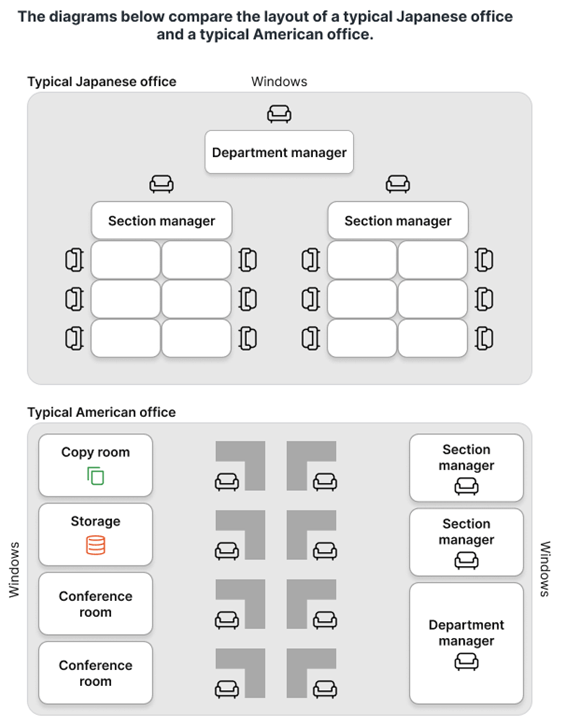5+ The diagrams below compare the layout of a typical Japanese office and a typical American office
The diagrams below compare the layout of a typical Japanese office and a typical American office. Summarise the information by selecting and reporting the main features, and make comparisons where relevant. Write at least 150 words hay nhất giúp bạn có thêm tài liệu tham khảo để viết bài luận bằng Tiếng Anh hay hơn.
- The diagrams below compare the layout of a typical Japanese office and a typical American office (mẫu 1)
- The diagrams below compare the layout of a typical Japanese office and a typical American office (mẫu 2)
- The diagrams below compare the layout of a typical Japanese office and a typical American office (mẫu 3)
- The diagrams below compare the layout of a typical Japanese office and a typical American office (mẫu 4)
- The diagrams below compare the layout of a typical Japanese office and a typical American office (mẫu 5)
- The diagrams below compare the layout of a typical Japanese office and a typical American office (mẫu 6)
- The diagrams below compare the layout of a typical Japanese office and a typical American office (mẫu 7)
- The diagrams below compare the layout of a typical Japanese office and a typical American office (mẫu 8)
- The diagrams below compare the layout of a typical Japanese office and a typical American office (mẫu 9)
- The diagrams below compare the layout of a typical Japanese office and a typical American office (mẫu 10)
- The diagrams below compare the layout of a typical Japanese office and a typical American office (mẫu 11)
- The diagrams below compare the layout of a typical Japanese office and a typical American office (mẫu 12)
- The diagrams below compare the layout of a typical Japanese office and a typical American office (mẫu 13)
- The diagrams below compare the layout of a typical Japanese office and a typical American office (mẫu 14)
5+ The diagrams below compare the layout of a typical Japanese office and a typical American office
Đề bài: The diagrams below compare the layout of a typical Japanese office and a typical American office. Summarise the information by selecting and reporting the main features, and make comparisons where relevant. Write at least 150 words
The diagrams below compare the layout of a typical Japanese office and a typical American office - mẫu 1
The pictures compare the layout of a typical office in Japan and America.
Overall, the office setups in Japan and America are diametrically different, with the former encouraging collaboration at the workplace and the latter reflecting the independent working style.
In Japan, tables of members in the same team are placed together to facilitate group discussions, forming two large areas, each of which is overseen by a section manager. Meanwhile, the space of an American office is divided into separate cubicles with high walls to minimize distractions. The working station of the Japanese department manager directly faces the joint desks of his subordinates, offering him an overall view to monitor all the activities in the office. By contrast, the working spaces of the management team including two section managers and one department manager are located separately with partitions on the East side of the American office.
There is only one window at the back of the department manager's seat in the Japanese layout whereas two windows are set up to stretch across the Western and the Eastern walls in the American office. While the office in America is equipped with a printer copier, a storage and two conference rooms, there are no such facilities in the Japanese office.
The diagrams below compare the layout of a typical Japanese office and a typical American office - mẫu 2
The diagrams provide an insight into the layouts of a typical American and Japanese office, highlighting the main features and the functional areas of each.
The foremost contrast between the two office setups is the arrangement of desks and the presence or absence of certain facilities. While the American office demonstrates individualized workspaces and various amenities, the Japanese model features communal workspace divisions under the direct supervision of management. In terms of workspace arrangement, the Japanese model groups desks into two larger areas, each overseen by a section manager. In contrast, the American office designates individual cubicles for each employee, suggesting a distinct preference for personal workspaces. Interestingly, while the Japanese office has one window situated at the back of the department manager's seat, the American counterpart is equipped with two windows on the left and right walls, possibly indicative of differing considerations for natural lighting.
Regarding the provision of facilities, the Japanese layout is notably minimalistic, featuring no additional amenities beyond a solitary chair placed in the far corner. In stark contrast, the American office houses a printer, copier, and storage space on the left side, with conference rooms also available for use. Additionally, the section managers and the department manager are situated on the right side of the American office.
The diagrams below compare the layout of a typical Japanese office and a typical American office - mẫu 3
The illustrations compare the configurations of a typical office in Japan and America. Generally, Japanese offices are designed to facilitate discussions among employees and supervision of managers, while offices in America emphasize individual privacy and hierarchy.
Regarding the arrangement of seating, in Japan, personnel are organized by sections. The employees are positioned parallel to each other around a rectangular table, which allows effective communication and exchange of ideas. The section manager is seated between the two lines so that he or she can supervise the work of their team members, while the department manager occupies the central seat to oversee the entire office’s operations. In comparison, offices in America are compartmentalized into distinct functional areas. In the middle are several separated L-shaped tables, each of which serves as the working space for an employee. Managers are arranged in adjoining rooms on one side of the office, highlighting the hierarchical framework of the institution.
Turning to other features, Japanese offices are equipped with a single large window and two doors, all situated behind the department manager’s workspace. Conversely, American offices leverage natural light with windows on two sides, whereas the doors are placed in each corner of the room. There is also a designated section for photocopiers, storage, and conference rooms in American offices, which are the features absent from the more spacious Japanese offices.
The diagrams below compare the layout of a typical Japanese office and a typical American office - mẫu 4
The floor plans illustrate two distinct office layouts, one typical of Japanese design and the other representative of American style.
Overall, the office layout in Japan tends to be designed to facilitate a hierarchical yet communal working environment, with the provision of only tables and chairs. In contrast, the American office provides individual workspaces and incorporates additional rooms for specific functions.
In a typical Japanese office, the department manager’s desk is located at the head of the office where they can overlook the employees in the room. In front of the department manager’s desk are two section manager desks, one on either side of the room. Likewise, the section managers are able to monitor their subordinates sitting at a block of six desks in front of them.
On the other hand, the department manager’s working space in an average American office is situated in one corner of the room, adjacent to which are two section manager offices. Meanwhile, the staff desks are individually organized in rows in the middle of the office space. Unlike the Japanese office, that of the American includes a printer room, storage space, and two conference rooms on the opposite side of the room. Finally, the latter typically has more windows than the former, with large windows installed on two sides of the room.
The diagrams below compare the layout of a typical Japanese office and a typical American office - mẫu 5
The maps present the differences between typical offices in America and Japan. Overall, Japanese companies prefer an open working space, and it also has a more hierarchical structure with managers presented with clear views of employees, whereas an American office is divided into designated sections and rooms for managers and work-related facilities.
Looking at the entrance and windows, an office in the United States generally has twice as many doors and windows as one in Japan. Specifically, the diagram presents four doors at each corner of the rectangular floor plan and two long sets of windows on either wall of an American office area, whereas a Japanese working space is presented with just two doors and one window installed along a wall at the top.
Regarding the interior layout, there are two rooms for section managers and a larger one for a department manager on the right side of an American office. Desks for employees are arranged in two rows in the center, with a printer room, storage area and two conference rooms located to the left of the office. In comparison, the seating arrangement of a Japanese office reflects a clearer management hierarchy with a wide department manager desk and two smaller section manager desks at the top of the single room. Their subordinates face each other and share large rectangular tables in the lower section of the layout.
The diagrams below compare the layout of a typical Japanese office and a typical American office - mẫu 6
The diagrams vividly juxtapose Japanese and American office designs, illustrating the cultural dichotomy in workplace ethos.
Overall, the Japanese layout, with its open-plan structure, fosters collective engagement and managerial transparency. Conversely, the American design, with its emphasis on individual spaces and defined hierarchy, mirrors a preference for privacy and organizational stratification.
Commencing with the Japanese office, it is characterized by a central, prominent desk for the department manager, positioned to oversee the entire workspace. This pivotal location facilitates an efficient supervisory role. Flanking this central command are desks for the section managers, leading to two parallel rows of employee desks. This arrangement promotes an open and collective working environment where interaction and oversight are seamlessly integrated.
Transitioning to the American office, the layout shifts to a more compartmentalized design, indicative of a preference for privacy and individual workspaces. Here, windows punctuate both sides of the office, bathing the space in natural light. The layout is thoughtfully divided into functional zones, with a printer/copier room and storage space anchoring the left corner. This strategic placement underscores the emphasis on operational efficiency. Furthermore, two conference rooms are tactically located to foster collaborative yet private meetings. The section managers' spaces, situated adjacent to the department manager’s room, suggest a clear hierarchical structure, while the employee desks are arranged in isolated clusters, providing each individual with a defined personal area.
The diagrams below compare the layout of a typical Japanese office and a typical American office - mẫu 7
The provided Layouts offer an insightful comparison between a typical American and a Japanese office, each reflecting distinct cultural nuances in workplace design.
Overall, the layouts reveal that the Japanese preference for open, collaborative spaces, against the American emphasis on individualized, hierarchical work environments, each mirroring their respective cultural work values.
The Japanese office layout, characterized by its open-plan structure, places the department manager's desk centrally, serving as a strategic vantage point for overseeing the workspace. This central positioning not only signifies managerial importance but also facilitates an interactive and collective environment, vital in Japanese work culture. Surrounding this are the section manager's desk and parallel rows of employee desks, arranged to promote accessibility and seamless communication.
In contrast, the American office presents a markedly different approach. The layout, favouring compartmentalization, features individualized spaces, reflecting the American emphasis on personal workspace and privacy. Windows flank the sides of the office, ensuring ample natural light, which is a thoughtful touch to enhance work comfort. The office is thoughtfully segmented into distinct zones: a printer/copier room and storage space are located on one side, optimizing operational efficiency, while conference rooms are situated to facilitate private and collaborative meetings. The department and section managers' spaces are strategically positioned to denote a clear hierarchical system, reinforcing the American workplace ethos of structure and individuality.
The diagrams below compare the layout of a typical Japanese office and a typical American office - mẫu 8
The maps compare the typical workspace of Japanese office workers with that of Americans.
The two models display striking differences, including the organization of tables and chairs, along with the arrangement of windows. Another difference involved is the number of facilities available within the office’s capacity.
As for the distribution of tables and chairs, the Japanese use large collaborative group tables, with a row of chairs for staff along each side. At one end of these tables lies a chair for a section manager, adjacent to an individual table and chair for the department manager. In contrast, American staff is assigned independent L-shaped tables together with chairs, all placed in the middle of the room. The working area for managers, located to the right, is separated from that for staff.
Windows in the Japanese office are concentrated behind the department manager, while those in the American workspace are installed on the sides.
Unlike their Japanese counterparts, American office workers are provided with several facilities, such as a printer and copier, a storage zone, and two conference rooms, right inside the office.
The diagrams below compare the layout of a typical Japanese office and a typical American office - mẫu 9
The comparative images delineate the contrasting layouts of a standard office in Japan and America.
Overall, Japan favors a collective working environment, while America emphasizes an individualistic work style.
In the Japanese office, the arrangement is notably centered around promoting collaboration among team members. Tables are clustered together, organized into two expansive areas, each overseen by a section manager. The department manager’s workstation is strategically positioned to overlook the joint desks of subordinates, granting them a comprehensive view to supervise office activities. Conversely, the American office space is compartmentalized into distinct cubicles, demarcated by tall partitions, aimed at minimizing distractions and fostering individual focus. The managerial team’s workstations, including two section managers and one department manager, are situated separately, partitioned off on the east side.
There is a discernible contrast in the presence of natural light sources. The Japanese office layout is characterized by only one window positioned behind the department manager’s seat. In contrast, the American office features two windows stretching across the western and eastern walls, illuminating the workspace. Additionally, while the American office is equipped with amenities such as a printer, copier, storage facilities, and two conference rooms, the Japanese office lacks these provisions.
The diagrams below compare the layout of a typical Japanese office and a typical American office - mẫu 10
The pictures compare the layout between an ordinary American office and a Japanese one. Overall, the American style is more accessible with extra doors and windows, along with separate amenity rooms. Additionally, Japanese offices feature collaborative workspaces, whereas American ones facilitate individual workstations.
Regarding conventional Japanese offices, windows are positioned between the two entrances situated in the upper extremities of the space. A department manager desk is located in the top midsection with its back against the windows. Below this are two workstations housing section managers facing downwards to a collection of staff tables and chairs that are adjacent to one another.
Concerning regular American offices, four doors are situated in the four corners and windows are placed on both sides. Working areas for employees are spatially separated and arranged in the center of the office, from the top to bottom, each consisting of an L- shaped table and a chair. A printer and copier section, storage, and two conference rooms are constructed separately from the top to the lower left, respectively; meanwhile, two individual section manager rooms and a department manager office are located on the right.
The diagrams below compare the layout of a typical Japanese office and a typical American office - mẫu 11
The visual comparison illustrates two distinct office setups: the traditional Japanese office and the contemporary American office.
Overall, Japanese offices typically embrace an open-plan layout, with no private rooms and a preference for communal workspaces. In contrast, American offices tend to follow a more traditional layout, featuring a higher proportion of private offices and cubicles.
Regarding Japanese offices, private rooms are usually absent, and departments are often grouped together. These offices adhere to a hierarchical structure, positioning the department manager centrally, flanked by two section managers within their respective teams. The workspace consists of expansive communal tables with chairs lined up on each side, promoting direct interaction among employees. Windows are only situated behind the department managers, while the rest of the office lacks windows.
Conversely, American-style offices feature an open space at the center, furnished with L-shaped tables and chairs designated for individual employees. On one side, each manager occupies a private room, with the department manager having the largest one. On the opposite side, there are additional facilities such as a copy room, storage space, and two conference rooms, amenities notably absent in Japanese offices. Windows are installed on both sides of these American offices.
The diagrams below compare the layout of a typical Japanese office and a typical American office - mẫu 12
The given diagrams illustrate the structural differences between a standard office in Japan and the United States.
The office configurations in the two countries are markedly distinct, reflecting divergent approaches to workspace organization. While the Japanese office prioritizes collaborative work, the American office embraces an independent working style.
In Japan, employees are strategically positioned in joint desks, fostering group interactions. The workspaces of the section and department manager, which follow a hierarchy design, are placed to overlook the workstations of subordinates, allowing comprehensive monitoring. Conversely, in America, where the size of one’s workspace corresponds directly to their position. Each staff member is allocated in individual cubicles with high walls and high-ranking executive officers have their own private rooms, both of which ensure privacy.
When it comes to utilization, the team-oriented layout of Japan can accommodate a greater number of workers with its minimalism style compared to American space. However, the U.S setting has more windows and specific function facilities like copier, storage and conference rooms.
The diagrams below compare the layout of a typical Japanese office and a typical American office - mẫu 13
The diagrams depict variances in office layouts between the United States and Japan.
In general, a Japanese office has the characteristic of being an open-plan and hierarchical workspace, allowing managerial oversight of subordinates. In contrast, an American office is divided by partition walls and segmented into various designated cubicles for work-related purposes and rooms for management positions.
Starting with entrances and windows, an American office typically features twice as many doors and windows compared to its Japanese counterparts. Specifically, four entry doors for the American office are positioned at each of the four corners of its rectangular office layout, along with two expansive windows that largely span the western and eastern walls.
On the contrary, a Japanese office consists of only two entrance doors located in the front left and right corners, along with windows that cover one third of the northern wall.
Regarding the interior layout, upon entering the American office through the northeast door, managers have access to two areas designated for section managers and one for a department manager. Desks and chairs are arranged in two rows in the central area of the office. On the left side, there is a room for printers and copiers, as well as a storage area. To the south of these areas, there are two conference rooms.
In contrast, the seating arrangement in a Japanese office clearly reflects the management hierarchy, with a long desk for the department manager positioned just behind the windows. Across the two sections reserved for managers, six workers share a common work table within each section, arranged to face each other and supervised by a section manager.
The diagrams below compare the layout of a typical Japanese office and a typical American office - mẫu 14
The two diagrams illustrate the arrangement in a standard American office compared with that in a Japanese office.
Overall, both offices represent significantly different layouts and functional facilities. The Japanese office prefers a communal working area for supervisors and subordinates, whereas Americans prefer simplicity which provides private space for managers and employees.
The whole sitting area in a Japanese office is shaped like a pyramid, with employees sitting around rectangular tables adjacent to the section managers and department managers. In the American office, however, there are eight semi-closed cubicles in the central area where employees can intermingle. The department and section managers are evenly separated in different cabins.
Another main difference is that there are many specific areas in the American office, such as conference room, storage, and copy. Yet, no such office facilities can be seen in the Japanese office. Besides, the Japanese office enjoys a huge window towards the north behind the department manager, while the windows in the American office are sited on either side, nearly stretching across the whole wall.
Xem thêm các bài luận Tiếng Anh hay khác:
Đã có app VietJack trên điện thoại, giải bài tập SGK, SBT Soạn văn, Văn mẫu, Thi online, Bài giảng....miễn phí. Tải ngay ứng dụng trên Android và iOS.
Theo dõi chúng tôi miễn phí trên mạng xã hội facebook và youtube:Nếu thấy hay, hãy động viên và chia sẻ nhé! Các bình luận không phù hợp với nội quy bình luận trang web sẽ bị cấm bình luận vĩnh viễn.
- Đề thi lớp 1 (các môn học)
- Đề thi lớp 2 (các môn học)
- Đề thi lớp 3 (các môn học)
- Đề thi lớp 4 (các môn học)
- Đề thi lớp 5 (các môn học)
- Đề thi lớp 6 (các môn học)
- Đề thi lớp 7 (các môn học)
- Đề thi lớp 8 (các môn học)
- Đề thi lớp 9 (các môn học)
- Đề thi lớp 10 (các môn học)
- Đề thi lớp 11 (các môn học)
- Đề thi lớp 12 (các môn học)
- Giáo án lớp 1 (các môn học)
- Giáo án lớp 2 (các môn học)
- Giáo án lớp 3 (các môn học)
- Giáo án lớp 4 (các môn học)
- Giáo án lớp 5 (các môn học)
- Giáo án lớp 6 (các môn học)
- Giáo án lớp 7 (các môn học)
- Giáo án lớp 8 (các môn học)
- Giáo án lớp 9 (các môn học)
- Giáo án lớp 10 (các môn học)
- Giáo án lớp 11 (các môn học)
- Giáo án lớp 12 (các môn học)






 Giải bài tập SGK & SBT
Giải bài tập SGK & SBT
 Tài liệu giáo viên
Tài liệu giáo viên
 Sách
Sách
 Khóa học
Khóa học
 Thi online
Thi online
 Hỏi đáp
Hỏi đáp

